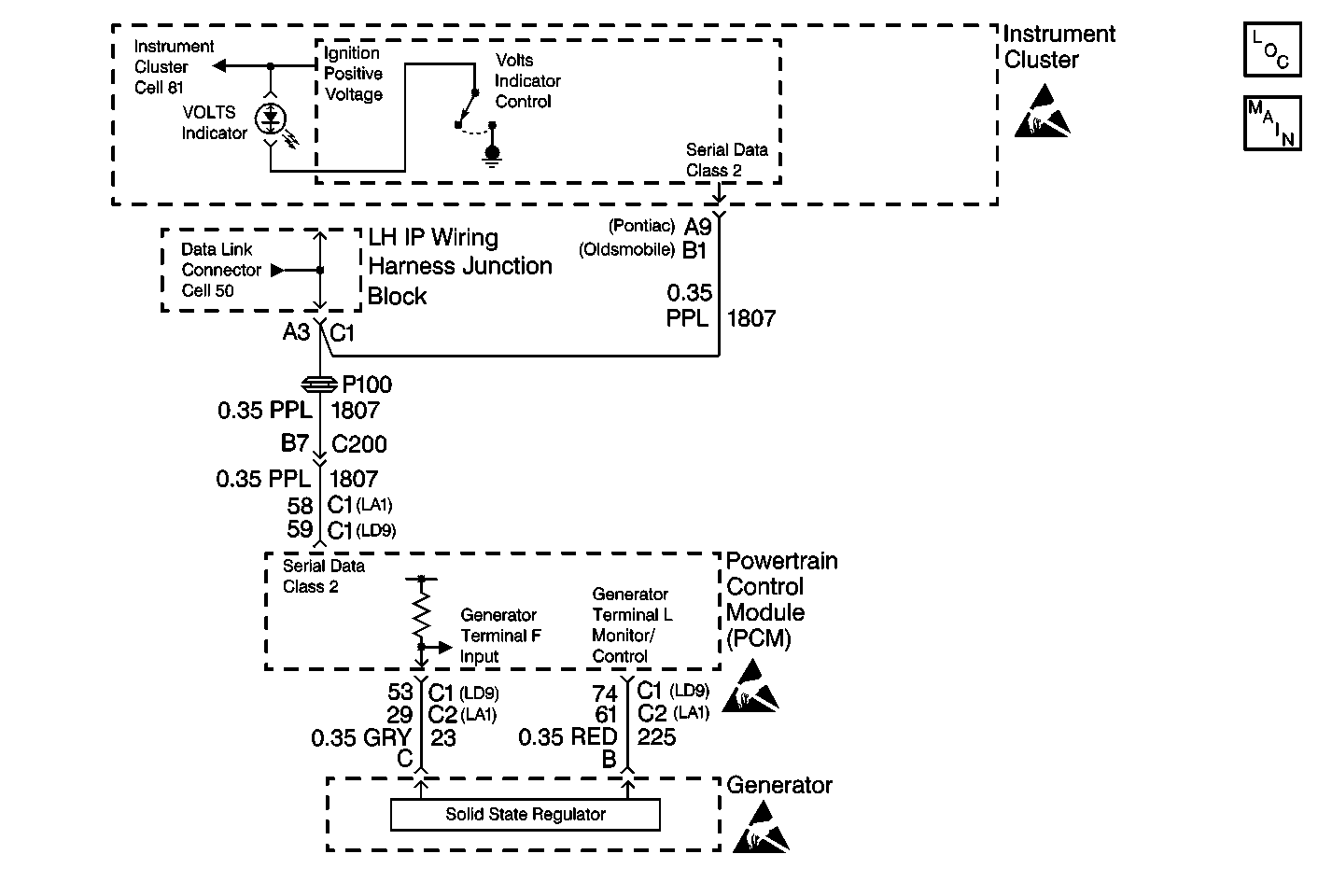
Circuit Description
This DTC determines if a fault exists that renders the generator F-terminal continuously HIGH.
Conditions for Setting the DTC
All of the following conditions must be met:
| • | The engine is running. |
| • | The powertrain control module (PCM) is sending the engine-RPM-is-zero Class 2 Serial Data message. |
| • | The powertrain control module (PCM) is sending the class 2 serial data message indicataing that the generator PWM is not less than 64% duty cycle for 30 seconds. |
Action Taken When the DTC Sets
| • | The instrument cluster stores DTC B1493 in memory. |
| • | The volts indicator will illuminate. |
Conditions for Clearing the DTC
| • | The instrument cluster goes to sleep. The controller reinitializes with the fault cleared. |
| • | All instrument cluster history codes will be cleared after 100 ignition cycles (from OFF to RUN) with no current codes active during the 100 ignition cycles. |
| • | Use the scan tool. |
Diagnostic Aids
| • | When the diagnostics direct you to take electrical measurements at the terminal assignments of the Wiring Harness Junction Blocks, refer to Power Distribution. This measurement is for terminal assignments of the Wiring Harness Junction Blocks. |
| • | If the DTC is a history DTC, the problem may be intermittent. Perform the tests shown while wiggling the wiring and connectors. This may often cause the malfunction to appear. |
An intermittent may be caused by any of the following conditions:
| • | A poor connection |
| • | Wire insulation that has been rubbed through |
| • | A broken wire inside the insulation |
Inspect for a poor connection of a damaged harness. Inspect all of the harnesses and connectors for the following conditions:
| • | Improper mating |
| • | Broken locks |
| • | Improperly formed or damaged terminals |
| • | Poor terminal-to-wire connections |
| • | Damaged harnesses |
Test Description
The numbers listed below refer to the numbers on the diagnostic table.
-
This step determines if the Powertrain Control Module (PCM) is reading a false generator PWM input.
-
This step determines if the Powertrain Control Module (PCM) is reading a high generator PWM measurement.
-
This step determines if CKT 23 has a short to B+ condition.
Step | Action | Value(s) | Yes | No |
|---|---|---|---|---|
|
Important: A short to ground will cause an open fuse(s). Before performing this diagnostic procedure, inspect the fuse(s) for an open. | ||||
1 | Was the Instrument Cluster Diagnostic System Check performed? | -- | Go to Step 2 | |
Is the generator PWM within the specified range? | -- | Go to Step 3 | Go to Step 5 | |
Is the generator PWM reading greater than the specified value? | 50% | Go to Step 4 | Go to Step 5 | |
4 | Replace the generator. Refer to Generator Replacement in Engine Electrical. Is the circuit repair complete? | -- | Go to Step 8 | -- |
Is the measured voltage equal to the specified value? | 0 V | Go to Step 7 | Go to Step 6 | |
6 | Repair the short to B+ in CKT 23 between the generator terminal C and the PCM connector C2 terminal 29 (connector C1 terminal 53 for LD9). Refer to Wiring Repairs in Wiring Systems. Is the circuit repair complete? | -- | Go to Step 8 | -- |
7 | Replace the PCM. Refer to Powertrain Control Module Replacement (2.4L) or Powertrain Control Module Replacement/Programming (3.4L) in Engine Controls. Is the repair complete? | -- | Go to Step 8 | -- |
8 | Clear the DTCs from the memory. Are the DTCs cleared from the memory? | -- | -- | |
